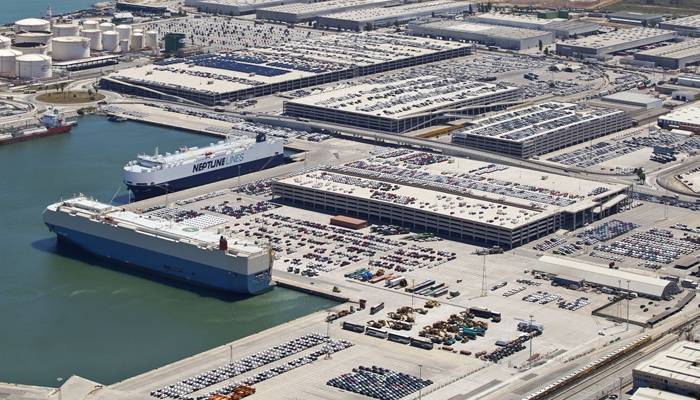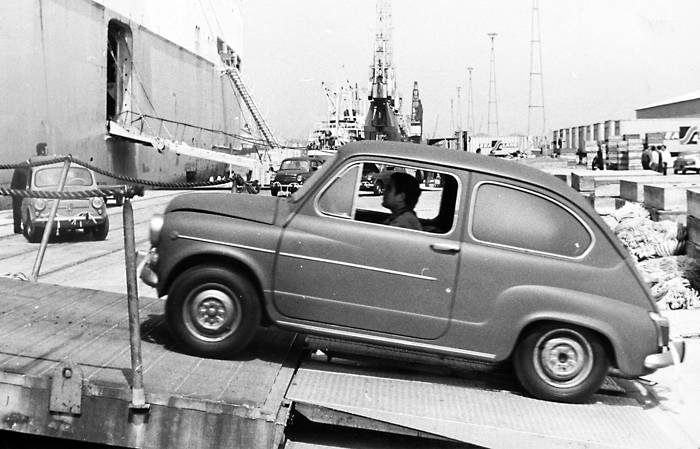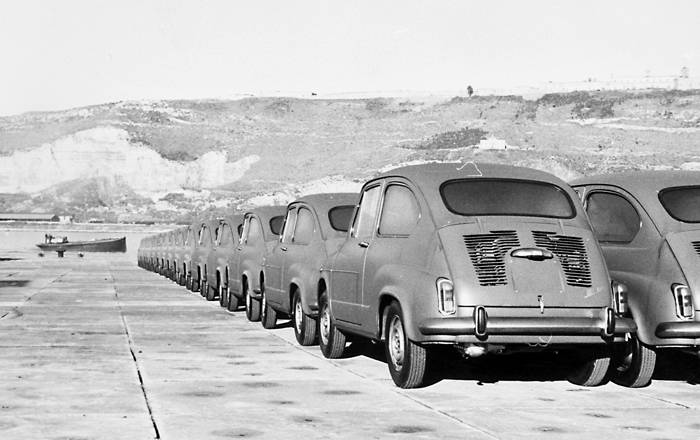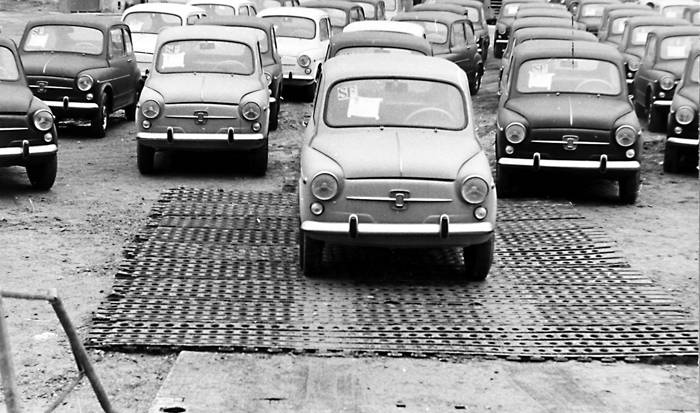The automotive industry developed during the 20th century in Barcelona, Spain's principal industrial city and the center of one of Europe's four key development driving regions. The Port of Barcelona claims a leading role in the development of this sector throughout its history, and today it is one of its main factors of competitiveness, both for finished vehicles and containerized part traffic.
When the industry began to develop in Catalonia, with manufacturers like Hispano Suiza and Elizalde, which achieved international renown, the Port became the gateway for the entry of all the parts and components still not manufactured in the country, as well as the point of import and export of finished vehicles. One example of the potent combination of port and industry is that the American manufacturer Ford set up an assembly factory in Southern Spain in 1920 and decided to move the whole production chain to Barcelona three years later.
The Civil War and the subsequent years of dictatorship led to a radical change in this scenario. Work began to start building the factory of the Sociedad Española de Automobiles de Turismo (SEAT) in the early 1950s in the Tax-free area, a condition demanded by its technology partner FIAT, which needed the factory near the Port of Barcelona to bring supplies from Italy for the early SEAT 1400 and 600 models. The large factory SEAT currently has in Martorell opened in 1993 and continues to have excellent road and rail connections with the port.
A consolidated and expanding industry
The other large car factory in Barcelona today, owned by the multinational Nissan, is also located in the tax-free area, which had been occupied since the 1960s by the firm Motor Ibérica, S.A. Both factories are currently building vehicles for various brands in their multinational groups, and plans are underway to develop new models in the coming years.
Barcelona is the principal port in the Mediterranean and one of the leaders in Europe for new vehicle traffic, with 748,000 units handled during 2014. The port has a 25 percent share of Spanish maritime vehicle traffic, with 85 percent of such vehicles sent for export in the past year. These figures are also reflected in the Port of Barcelona: 13.5 percent (totaling 431,440 units) of new vehicles that passed through the Port in 2014 were for export; 15 percent (or 123,242 units) were for import; 20 percent, or a total of 97,533 units, were transported by cabotage to other Spanish ports and the remaining 96,000 vehicles were in transhipment regime.
Specific sector services
This leading position was achieved thanks to the quantity and quality of the specific sector services. The port has two specialized vehicles terminals - Autoterminal and Setram - and caters to new vehicles at the Acciona cabotage terminal, the Barcelona Grimaldi Terminal - used for short sea shipping and ferry ships - and the Port Nou multipurpose terminal.
Autoterminal and Setram offer a total storage of more than one million square meters, almost half of which are covered by four-storey parking areas. Both terminals offer value-added services to their customers, such as tuning prior to delivery to the dealer, adapting different models for specific markets, etc.
The two specialized terminals have six berths for car-carriers (four for ocean-going ships) and a 25-hectare area to facilitate major loading and unloading operations and spikes in traffic. This large area, reserved for the future expansion of vehicle traffic, is already available for the terminals, which use it for mass transhipment operations requiring large areas. In addition, the port has now built the new rail terminal for vehicles on Príncep d’Espanya wharf, which facilitates marine and rail logistics.
A commitment to rail
Vehicles of all brands produced or marketed in Spain pass through the Port of Barcelona. The port has opted for rail services to connect with the production plants. The first, in terms of volume and frequency, is the Autometro service that connects the SEAT factory with the port. Operated by Ferrocarrils de la Generalitat de Catalunya, it has three daily circulations and moves more than 100,000 cars a year. There is also a daily train to the Landaben Volkswagen factory in Pamplona, one to Valladolid and Palencia, and a weekly train to Avila. Trains also operate from Figueruelas (Zaragoza), Madrid and Vigo, at different, growing frequencies.
The port has been building railway facilities at the various terminals to provide a fast and efficient service to the industry. In addition to the Autoterminal and Setram rail terminals on the South dock and the one already mentioned on Príncep d’Espanya wharf, another terminal has been built on Costa wharf, affording trains direct access to the Grimaldi and Acciona terminals.
The sum of the significant volume of traffic starting and ending in various parts of Spain and Europe and the port's good connections and multimodal services makes it possible to generate synergies and boost vehicles traffic by sea and rail. The vehicle terminals have rail connections using three gauges (Iberian, UIC and metric) and a rail terminal to be extended to 750 m in 2016.
Barcelona is the only port in Spain at which it is possible to make a direct transfer from an Iberian gauge train to a UIC gauge one, which has made it possible to set up a new rail service with four weekly trains in UIC gauge linking with Markolsheim (Northern France): southbound trains transport vehicles manufactured in France towards the Spanish and Algerian markets while the northbound ones carry vehicles manufactured in Zaragoza to the European market.
A full range of maritime connectivity
The Port of Barcelona offers a full range of logistics services for the automotive sector, on the maritime side, with an offer of long- and short-distance maritime connectivity covering all of importers' and exporters' needs.
The port could point to services with the Far East, an area that has traditionally provided significant import traffic, and in recent years has also become a receiving area for vehicles manufactured in Spain. The ports of the Middle East are also linked to Barcelona with four fortnightly services. Other long-distance services link the port and North America and have turned Mexico into a key trading partner for this industry with Barcelona, in both export and import traffic. Destinations such as South Africa and Oceania, traditional customers of some models manufactured in Barcelona, also enjoy regular connections.
Short sea traffic ensures the distribution of vehicles from far-flung markets that must be carried to their final destination, and vehicles manufactured in Europe and exported to other countries in North Africa, countries of the Eastern Mediterranean and the Balearic and Canary Islands.
Greater capacity and more frequencies
The shipping companies that operate this type of traffic - pure car-carrier vessels and ferries from nearby destinations - have increased the capacity of their ships and the frequency of their services to respond to the growth of the industry.
The supply chains needed to manufacture cars are increasingly complex and require efficient logistics services. The Port of Barcelona also leads the market in transporting automotive parts and disassembled vehicles, both for import and export. Catalonia has a powerful car parts industry that increasingly feeds factories located in South Africa, Morocco, Argentina, India and China. Similarly, globalization has meant that vehicles assembled in Europe contain parts from all over the world. One example is the regular container service which the Port of Barcelona operates with Zaragoza Maritime Terminal (TMZ) for the factory owned by the General Motors group in Figueruelas; 100 containers weekly with parts from South Korea leave the port by train to TMZ and from there by truck to the final destination. Once assembled, the vehicles are shipped by rail to Europe and, again by ship from Barcelona to other destinations worldwide.
This is a growing traffic, which has increased from 42,000 containers of parts recorded in 2013 to more than 50,000 containers last year. The first quarter of 2015 has already seen a year-on-year increase of 45 percent.





















